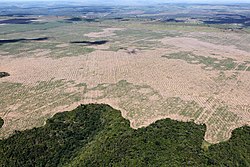Holocene extinction

The Holocene extinction is the extinction of nearly all large mammal species after the end of the ice age. This was done by humans hunting the animals, and by climate change.[1]
Habitat destruction and over-harvesting are two of the primary causes which drive species extinct in more recent times. The fundamental cause of this is the huge increase in human population since the agricultural revolution.
Forests and natural habitats have been greatly reduced throughout the world, and this has been the cause of many extinctions.
Holocene Extinction Media
The dodo became extinct during the mid-to-late 17th century due to habitat destruction, overhunting, and predation by introduced mammals. It is an often-cited example of a human-driven extinction.
The moa in New Zealand went extinct in the mid 15th century due to overhunting and habitat destruction by the Māori people. Prior to the arrival of the Māori a century earlier, New Zealand was uninhabited by humans.
A diagram showing the ecological processes of coral reefs before and during the Anthropocene
The percentage of megafauna on different land masses over time, with the arrival of humans indicated.
Deforestation in the Maranhão state, Brazil, in July 2016
- Top: Arid ice age climateMiddle: Atlantic period, warm and wetBottom: Potential vegetation in climate now if not for human effects like agriculture.
There are roughly 880 mountain gorillas remaining. 60% of primate species face an anthropogenically driven extinction crisis and 75% have declining populations.
References
- ↑ Martin P.S. & Klein R.G. (eds) 1984. Quarternary extinctions: a prehistoric revolution. Tucson: Arizona University Press. ISBN 0-8165-1100-4







